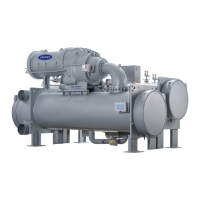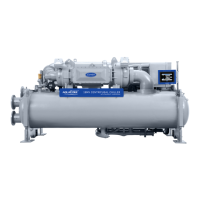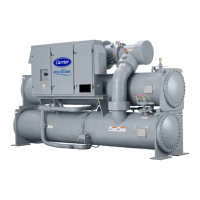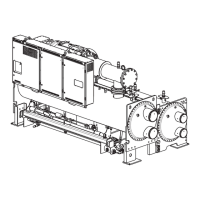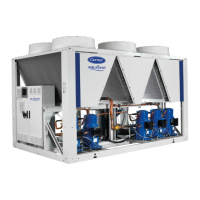79
single value transducers, disconnect the transducer’s electrical
cable, remove the sensor from its Schrader fitting, then recon-
nect the cable.
NOTE: If the cooler or condenser vessels are at 0 psig (0 kPa)
or are open to atmospheric pressure, the transducers can be
calibrated for the zero point without removal.
Access the HEAT_EX or COMPRESS screen under the
STATUS menu, and view the particular transducer reading
(OIL PRESSURE DELTA P is in the COMPRESS screen; all
others are in the HEAT_EX screen). If the displayed reading is
not 0 psi (0 kPa), press the SELECT key to highlight the
associated line in the display, then the ENTER key. (For zero
point calibration, the INCREASE and DECREASE keys have
no effect.) The value should change to 0.0.
If the ICVC fails to accept the zero point calibration, the
value will not change to 0.0 and the display will show “Higher
Force In Effect”. This indicates that the sensor voltage is out of
the acceptable range. For each single value transducer there are
3 terminals at the CCM: 0 vdc (low) connected to the black
wire, “sensor” voltage connected to the white or clear wire, and
5.00 vdc (high) connected to the red wire. With a base supply
voltage of 5.00 volts, the acceptable range of voltage taken
between the low (black wire) and sensor terminals (white or
clear wire) for zero point calibration is 0.40 to 0.55 v. For each
transducer differential pair there are two 3-terminal sets at the
CCM. With a base supply voltage of 5.00 volts, the acceptable
range of voltage taken between the sensor terminal (white or
clear wire) for the higher pressure transducer (liquid inlet or oil
pump discharge) and the sensor terminal (white or clear wire)
for the lower pressure transducer (liquid outlet or oil sump) for
zero point calibration is -0.065 to +0.085 v. If this occurs with a
differential pair, one possible remedy is to swap the high end
(e.g., inlet) and low end (e.g., outlet) transducers. In most cases
this puts the voltage difference of the sensor pair within the
acceptable range.
HIGH END CALIBRATION — High end calibration can be
performed between 25 and 250 psig (173 and 1724 kPa),
comparing the pressure readings in the ICVC display to an
accurate refrigeration gage. High end calibration may improve
transducer accuracy over the full pressure range. High end
calibration is not recommended for transducer differential
pairs. Pressure can be provided by attaching a regulated
250 psig (1724 kPa) pressure source, such as from a nitrogen
cylinder, to the transducer. It is good practice to perform the
high end calibration near a pressure that the sensor will
typically be exposed to.
Access the HEAT_EX screen under the STATUS menu, and
the CONDENSER PRESSURE or EVAPORATOR PRESSURE
to the reference pressure gage. To change the displayed read-
ing, press the SELECT key to highlight the associated line in
the display, then the INCREASE or DECREASE key to set the
new value, then the ENTER key. Generally, the value can be
changed to any value within ±15% of a nominal value.
NOTE: Prior calibrations may have shifted the present pre-
calibration value from the center of this range. In this case, the
limit of acceptable new values will be less than 15% in one
direction.
If the ICVC fails to accept the high end calibration, the
value will not change and the display will show “Higher Force
In Effect.” This indicates that the sensor voltage is out of the
acceptable range for the entered value. In this case, the
pressure transducer may need to be replaced.
Each pressure transducer is supplied with 5 vdc power from
the CCM through the red wire. Pressure transducer readings
are derived from voltage ratio, not absolute voltage, which
compensates for any reference voltage variation. If this power
supply fails, a transducer voltage reference alarm (239) is
generated. If transducer readings are suspected of being faulty,
check the supply voltage, measured between the high and low
(red wire and black wire) terminals of any transducer 3
terminal connection at the CCM. This is also displayed in
CONTROL TEST under PRESSURE TRANSDUCERS.
Check Optional Pumpout System Controls
and Compressor —
Controls include an on/off switch, a
0.5-amp fuse for the secondary side of the transformer,
0.25-amp fuses for the primary side of the transformer, the
compressor overloads, an internal thermostat, a compressor
contactor, refrigerant low pressure cutout and a refrigerant high
pressure cutout. The high pressure cutout is factory set to open
at 185 psig (1276 kPa) and reset at 140 psig (965 kPa).
The low pressure cutout is factory set to open at 7 psia (–15.7
in. Hg) and close at 9 psia (–11.6 in. Hg). Ensure the water-
cooled condenser has been connected. Ensure oil is visible in
the compressor sight glass. Add oil if necessary.
See the Pumpout and Refrigerant Transfer Procedures sec-
tion on page 86 and the Optional Pumpout System Mainte-
nance section on page 95 for details on the transfer of refriger-
ant, oil specifications, etc.
High Altitude Locations — Because the chiller is ini-
tially calibrated at sea level, it is necessary to recalibrate the
pressure transducers if the chiller has been moved to a high
altitude location. See the calibration procedure in the Trouble-
shooting Guide section.
Charge Refrigerant into Chiller
The standard 23XRV chiller is shipped with the refrigerant
already charged in the vessels. However, the 23XRV chiller
may be ordered with a nitrogen holding charge of 15 psig
(103 kPa). In this case, evacuate the nitrogen from the entire
chiller, and charge the chiller from refrigerant cylinders.
Chillers shipped with a factory charge should arrive with all
isolation valves in the open position. Figures 2-4 and 10-13
show the location of the isolation valves listed in the Initial
Start-Up Checklist.
CHILLER EQUALIZATION WITHOUT A PUMPOUT
UNIT
To equalize the pressure differential on a refrigerant isolated
23XRV chiller, use the TERMINATE LOCKOUT function of
CAUTION
The transfer, addition, or removal of refrigerant in spring
isolated chillers may place severe stress on external piping
if springs have not been blocked in both up and down
directions. Failure to block springs in both up and down
directions could result in severe personal injury and equip-
ment damage.
CAUTION
Always operate the condenser and chilled liquid pumps
during charging operations to prevent freeze-ups. Damage
may result to equipment if the condenser and chilled water
pumps are not operated during pumpdown or charging.
WARNING
When equalizing refrigerant pressure on the 23XRV chiller
after service work or during the initial chiller start-up, do
not use the discharge isolation valve to equalize because
the force that could be exerted by the valve handle could
cause personal injury. Either the motor cooling isolation
valve or the charging hose (connected between the pum-
pout valves on top of the cooler and condenser) should be
used as the equalization valve.

